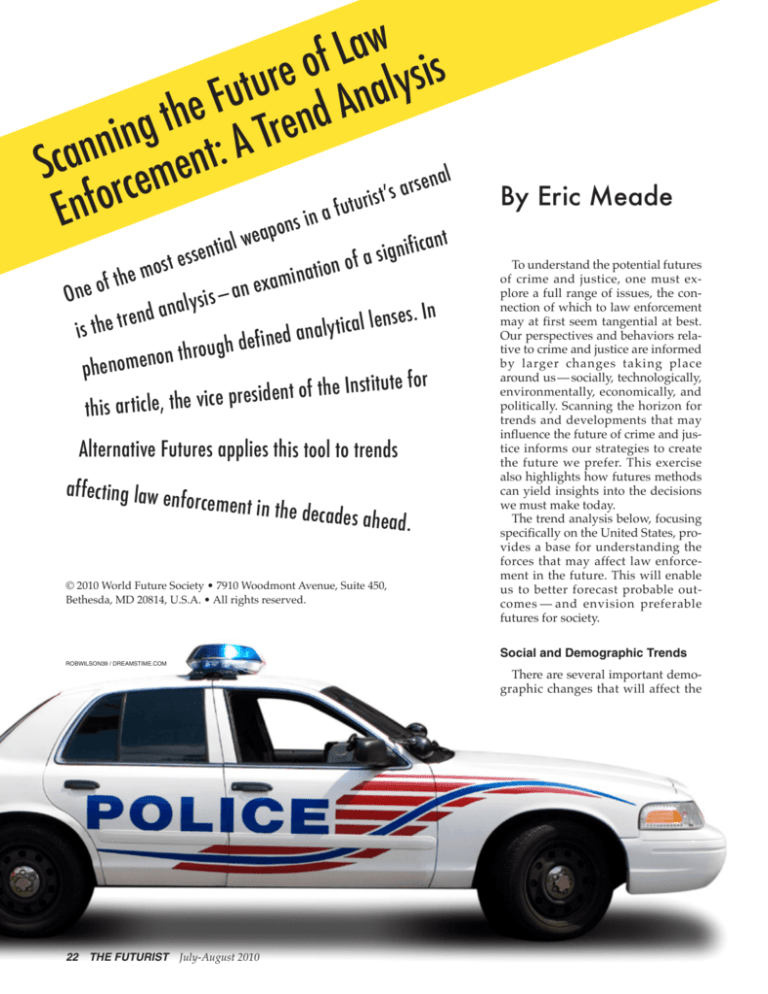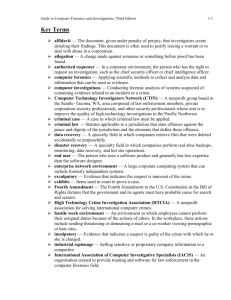
w
a
L
f
o
s
i
e
s
r
y
u
l
t
a
u
n
F
A
e
d
h
t
n
e
g
r
n
T
i
n
A
n
Sca cement:
enal
s
r
a
s
r
ris t ’
u
o
t
f
u
f
En
s in a
n
o
p
a
we
nt
On
he m
e of t
is the
ph
th
sen
os t es
al y s
n
a
d
n
tre
tial
is — a
n thr oug
enomeno
ati
n
i
m
a
x
ne
h de
signi
a
f
o
on
ical le
t
y
l
a
n
a
d
f ine
ent of the
d
si
re
p
e
ic
v
e
th
,
is article
f ica
nses. In
Institute for
Alternative Futures applies this tool to trends
affecting law e
nforcement in th
e decades ahea
© 2010 World Future Society • 7910 Woodmont Avenue, Suite 450,
Bethesda, MD 20814, U.S.A. • All rights reserved.
d.
By Eric Meade
To understand the potential futures
of crime and justice, one must explore a full range of issues, the connection of which to law enforcement
may at first seem tangential at best.
Our perspectives and behaviors relative to crime and justice are informed
by larger changes taking place
around us — socially, technologically,
environmentally, economically, and
politically. Scanning the horizon for
trends and developments that may
influence the future of crime and justice informs our strategies to create
the future we prefer. This exercise
also highlights how futures methods
can yield insights into the decisions
we must make today.
The trend analysis below, focusing
specifically on the United States, provides a base for understanding the
forces that may affect law enforcement in the future. This will enable
us to better forecast probable outcomes — and envision preferable
futures for society.
Social and Demographic Trends
ROBWILSON39 / DREAMSTIME.COM
22
THE FUTURIST
There are several important demographic changes that will affect the
July-August 2010
Are Virtual Crimes Real?
United States over the next decade.
Most strikingly, non-Hispanic whites
will continue to shrink as a percentage of the U.S. population, from 65%
in 2010 to 61% in 2020 and 50% in
2050. During this time, Hispanics
will make the greatest gains, reaching 24% of the population by 2050.
The increased attention paid to the
Hispanic community may marginalize vulnerable African American
populations, who will hold steady at
approximately 13% of the total U.S.
population. At the same time, marriage across racial and ethnic groups
may reduce the extent to which
Americans identify themselves with
one racial or ethnic group.
Another key demographic factor is
the generational shift now taking
place as the millennial generation replaces the “silent” and baby-boomer
generations before them in the workforce, electorate, and public. Similarly, the juvenile age bracket will
soon be made up of “Globals” (born
2004–?), about whom little has yet
been written and whose attitudes toward crime and justice are more difficult to anticipate.
Millennials tend to be more engaged in civic activities than other
generational cohorts and are more
likely to think that the government is
on their side. This attitude suggests
that they may accept law enforcement techniques and technologies
that earlier generations perceived as
violations of privacy. The millennials’ relatively high adoption of new
technologies and low sensitivity to
privacy concerns can already be seen
on social networking sites such as
Facebook and MySpace, where
young people regularly post detailed
information about their private lives.
This divergence from the values and
behaviors of previous generations
will also become significant to law
enforcement agencies as more millennials enter their ranks.
Another value shift that is occurring in U.S. society is attitudes toward low-level drug use. Many
Americans have come to view use of
some addictive substances more as a
health problem than as a criminaljustice problem.
Science and Technology Trends
The emergence of new technologies will doubtless lead to new forms
of crime. For example, expanded reliance on Internet technology has already created new forms of identity
theft, identity distortion, and online
extortion. The growth of virtual reality and online communities may extend crime from person to “avatar” — the character that represents
the user or acts as the user’s agent in
virtual reality. For example, in 2008 a
Japanese woman was arrested for
killing off the avatar of her virtual
ex-husband — that is, she illegally
logged in as him and destroyed his
character. As virtual worlds play a
larger role in our personal and economic lives, it is likely that these
crimes will grow in importance.
Back in the real world, new types
of crime will emerge as we spend
more of our lives online. Violent outbursts that occur in chat rooms or
e‑mails may be viewed as “cyberhate crimes.” Already, the use of mobile phones to exchange sexual messages and photos (called “sexting”)
has landed many people, including
adolescents, on the wrong side of the
law. Countless adults are already behind bars for targeting children online, or offering up their own children, for sexual purposes. As more
of our lives take place online and in
public view, it is likely that more behaviors will fall under the scope of
laws against hate crimes, child pornography, and sexual misconduct,
and that opportunities to participate
in those behaviors will proliferate.
Technological advancements will
give existing criminals new capabilities, often on a par with those of governments and law enforcement agencies. For example, the unmanned
robots and drones currently used by
the U.S. Army in Pakistan and Afghanistan could be used by gangs
and other criminal elements to attack
As technology enables new
forms of crime, it may be difficult
to establish whether or not a
crime has actually taken place
and where to assign responsibility. Examples:
•A Missouri teenager, ­Megan
Meier, committed suicide on the
day after a fraudulent online chat
partner suddenly broke off their
relationship.
•Two elementary school students posted a video, “Top Six
Ways to Kill Piper,” on YouTube,
in which they suggested ways to
kill a classmate they did not like.
Violent video games are often
cited as causing violent crime,
and criticism is likely to grow as
video games incorporate more
advanced virtual-reality technology. Similarly, media personalities on the far right have been
blamed for provoking the recent
shooting of a security guard at
the U.S. Holocaust Memorial.
Such episodes and reactions
may presage a broader definition
of responsibility for criminal acts
as technologies advance at an accelerated rate.
— Eric Meade
ISTOCKPHOTO
THE FUTURIST
July-August 2010
23
their prey or one another. Low-cost
unmanned airships or small submarines could be used to transport narcotics and other contraband. The use
of unmanned devices could hinder
efforts to assign responsibility to specific suspects or organizations.
New technologies will also be
available to law enforcement agencies. However, social values and
opinions will impact the ultimate
level of their acceptance or rejection.
For example, there is growing resistance to the use of conductive energy
devices (i.e., Tasers), particularly after a series of highly publicized
deaths. While there is widespread
support for DNA testing, the Supreme Court has ruled that defendants do not have a right to a DNA
test. In other cases, contamination or
alleged tampering of these samples
has served as a counterweight to
their general acceptance by the public. It is unclear how the public
would view greater extraction of information — facial features, ethnicity,
height, weight, etc. — from DNA, as
more and more health information
goes digital.
New technologies may emerge not
just to prosecute, but to punish as
well. For example, social networking
technologies may become so essential in the future that prohibiting
nonviolent convicts from using them
may have a deterrent effect similar to
that of incarceration today. RFID and
GPS bracelets are already used to
monitor house arrest and parole violations. These systems could be
linked to databases to provide
greater preventive policing of sex offenders and other dangerous criminals.
To some extent, these types of
monitoring technologies may be expanded to the general public, just as
closed-circuit TV cameras have been
installed extensively in London.
These systems may be further enhanced by innovations in profiling,
face recognition, gait analysis, and
biometrics. It is worth noting that
surveillance systems and GPS technology have gotten far ahead of the
laws governing their use.
Social networking sites may play a
much larger role in crime prevention
and in identifying unhealthy social
patterns while there is still time to
24
THE FUTURIST
July-August 2010
prevent the emergence of crime. For
example, police monitoring of social
networking sites may anticipate the
shift from ordinary adolescent tribal-
“At the national and international levels, there may
be a continued blurring of
the boundary between
counterterrorism and law
enforcement.”
communities that they serve. For example, police officers may use social
networking to alert the local population of unsafe areas or conditions.
Video games — especially simulations using virtual reality — could be
used to prevent crime by teaching
young people how to behave properly in society. Sophisticated modeling technology, similar to that now
being developed in the health sciences, could allow young people to
place “virtual twins” in criminal situations in order to evaluate their
own psychological and neurological
responses.
Economic Trends
ism to gang-related violence, just as
Google search data have been used
to identify flu outbreaks. Services
like Twitter may be used to anticipate criminal activity or to piece together the clues after the fact. In
other cases, social networking may
be used to organize community responses to crime or to civil rights violations by the authorities, similar to
the role that Twitter played following the Iranian elections last year.
Suspected criminals may also use social networking sites to alert their
lawyers immediately of their arrest,
or to coordinate their stories prior to
interrogation.
These technologies will give communities an opportunity to construct
systems of preventive and predictive
policing that will recognize behavioral patterns, diagnose unhealthy
social conditions, and tap into a data­
base of crime-prevention strategies
and outcomes to determine the best
approach. This approach would
likely require comprehensive sensing
through video surveillance, monitoring of social networking sites, and
direct community involvement by
police officers. Given its potential effectiveness, public willingness to
cede some privacy in the wake of
9/11, and the demographic changes
described above, this type of preventive and predictive law enforcement
may gain acceptance by the general
public.
Many of these technologies offer
new opportunities for law enforcement agencies to engage with the
What happens to the U.S. economy
over the next 10 years will have significant implications for crime and
law enforcement. While many indicators suggest that the recession may
be easing, unemployment reached
10.2% in October 2009 and is expected to remain above the historical
average for several years. This unemployment will drive higher levels
of ordinary crime, as well as the psychologically regressive crime in
which some breadwinners facing financial difficulty commit violent acts
against their own families.
At the same time, economic crisis
has driven budget cuts at the federal,
state, and local levels, which may reduce the effectiveness of crime prevention and control efforts. The state
of California faces deep budget cuts
in many areas, among them prisons
and law enforcement, after voters resoundingly defeated a set of proposed tax hikes. Law enforcement
agencies will likely find themselves
being asked to do more with less.
Urbanization may lead law enforcement agencies in rural areas to consolidate or shut down, while suburban agencies may be subsumed into
newly defined “metropolitan” regions. Budget constraints may affect
law enforcement policy, such as by
promoting the legalization of marijuana as a means to offset cuts in
prison funding (both by reducing the
numbers of criminals sent to prison
and by opening up a revenue source
if sales of marijuana were taxed like
tobacco).
Many jurisdictions may seek new
technologies and processes to facilitate effective law enforcement at a
lower ongoing cost, although the actual financial benefits are as yet unclear. For example, many of these
technologies will require upfront investment that may be beyond the capacity of the relevant authorities.
Budgets may also be cut for the innovation and research that would
lead to these new technologies.
Where new technologies — e.g., red
light cameras — are introduced, they
may reduce the revenue collected by
local authorities through fines, once
citizens have adjusted their behavior.
Smart vehicles that automatically select a safe speed may similarly reduce the revenue from moving violations.
Environment and Resource
Trends
Climate change could have immense implications for law enforcement in the United States. International refugees fleeing drought,
disease, or food shortages would create a significant social and economic
burden for communities and governments in industrialized countries.
Rising sea levels could dislocate populations and destabilize coastal areas
within the United States. Some areas
may enter a downward spiral, where
the rich leave, local investment suffers, and the people left behind have
fewer economic opportunities other
than crime.
Shortages of fuel, water, and other
natural resources may increase theft
of these resources. For instance, gasoline siphoning reminiscent of the
1970s might revive. In some cases,
criminals may profit through the illicit sale of untreated or tainted water. Regulations on toxic chemicals
may create new opportunities for
criminal elements to profit by providing illegal storage or disposal.
New markets created by a “cap-andtrade” system to reduce greenhouse
gas emissions may be vulnerable to
“green collar” crime — e.g., fraud,
corruption, and market manipulation similar to that often seen in financial markets. Identity theft may
emerge in these markets as “carbon
theft,” in which one entity takes on
another’s identity in order to enjoy
the benefit of their carbon credits.
Shortages of natural resources and
changing public attitudes may also
create new challenges for law enforcement. For example, many police
departments placed mileage restrictions on their patrol cars when gasoline prices passed $4 per gallon in
the summer of 2008. Forecasts for
“peak oil” suggest that, after the
economy recovers and energy demand returns to its earlier levels, declining supplies could send oil prices
steeply higher over the next decade.
Law enforcement agencies may respond by reducing patrol car use,
shifting to more fuel-efficient vehicles, focusing more on “virtual policing,” or assigning more police to
foot or bicycle patrols. Similarly,
public opinion may call for “green
prisons” and “green police stations,”
just as many are already calling for
“green universities” and “green offices.”
Government Trends
Demographic shifts may increasingly translate into political shifts
that have impacts on U.S. law enforcement. The face of the criminal
justice system will change with the
face of America, as seen in the appointments of Attorney General Eric
Holder and Supreme Court Justice
Sonia Sotomayor.
At the national and international
levels, there may be a continued
blurring of the boundary between
counterterrorism and law enforcement, leading many law enforcement
agencies into uncharted territory.
Planning for man-made and natural
disasters will prompt much greater
integration across local, state, national, and even international jurisdictions, as well as across law enforcement, fire, EMS, health, and
other services. A move toward integration is already evident in many
federal agencies and in specific recommendations such as those of the
bipartisan Project on National Security Reform.
Conclusion: Implications for Law
Enforcement
Clearly there is considerable overlapping in the trend categories ana-
lyzed above; economic conditions
have social and political impacts,
and technologies alter lifestyles and
attitudes, with often unexpected implications for criminal justice. By reviewing the larger trends at work in
the social, technological, economic,
environmental, and political contexts, we can better understand the
potential futures of crime and justice.
Across all generations and population groups, it is important to ask
how society will view crime and
punishment even one decade from
now. There is a growing fear that the
U.S. corrections system has failed in
its mission. Too many are incarcerated and too few are corrected — that
is, many never escape the cycle of recidivism.
Longitudinal studies find higher
mortality, higher health risks, and
higher unemployment among those
who have been released from prison
than among the general population.
Many thought-leaders suggest that
the U.S. criminal justice system has
failed to address many of the factors
that eventually lead to crime, such as
inequality of opportunity, health and
fitness problems, and inadequate education. Some suggest that the
United States has tolerated the conditions that lead to crime, only to
build more prisons to incarcerate the
criminals.
How will society define “crime”
and “justice” two or three decades
from now? What types of crime will
be of primary concern then that may
not even exist today? What paradigms for punishment, correction,
and reintegration into society will be
broadly accepted and institutionalized? Only by addressing questions
like these can we identify and implem e n t t h e s t r a t e g i e s — a n d v i sion — that will help us create the
future we prefer.
❑
About the Author
Eric Meade is vice president
and senior futurist at the
Institute for Alternative
Futures, 100 North Pitt
Street, Suite 235, Alexandria, Virginia 22314. E-mail
emeade@altfutures.com;
Web site www.altfutures.com.
THE FUTURIST
July-August 2010
25








